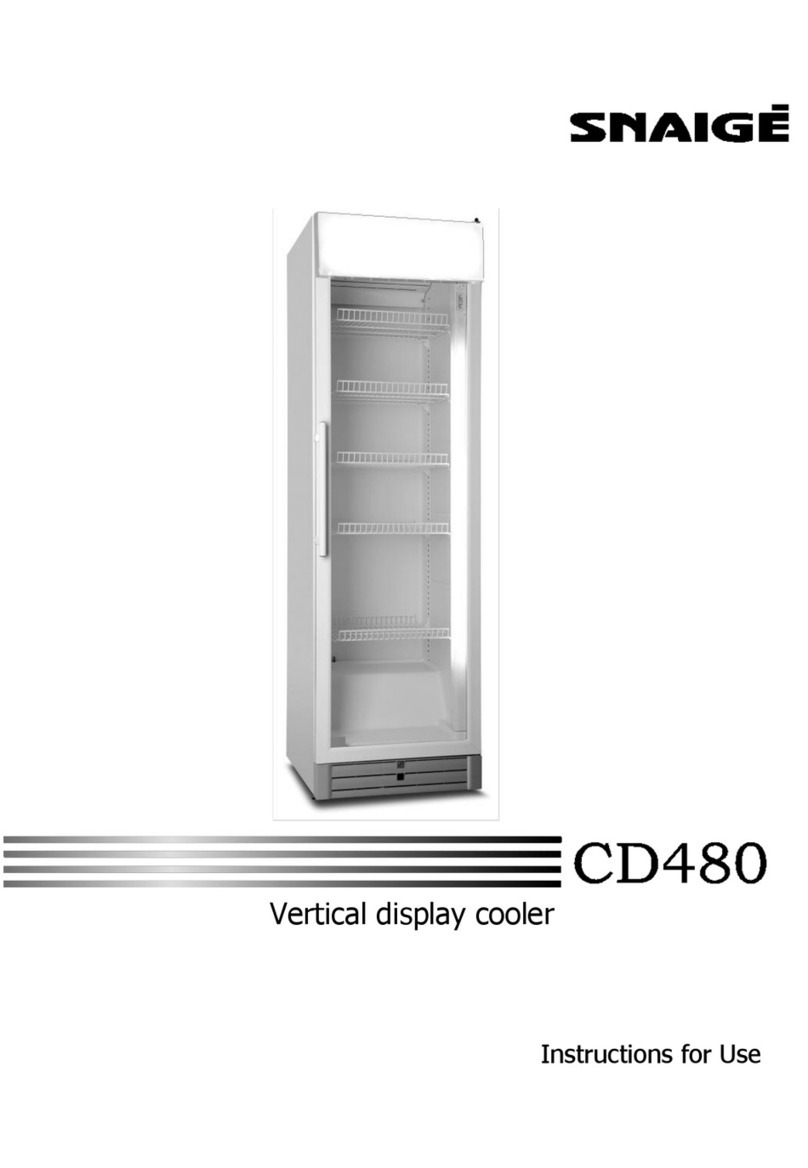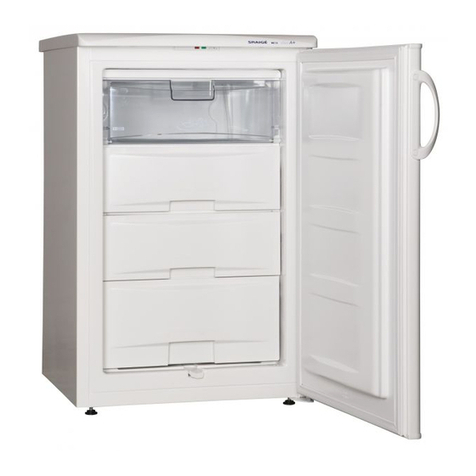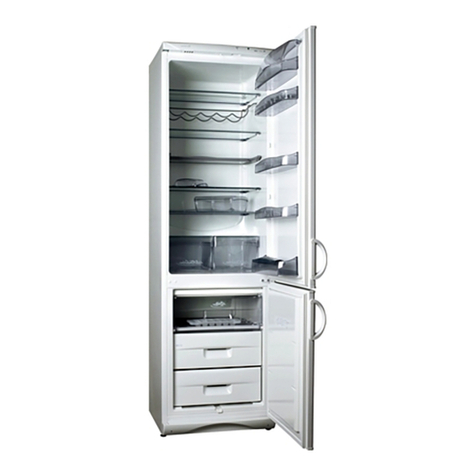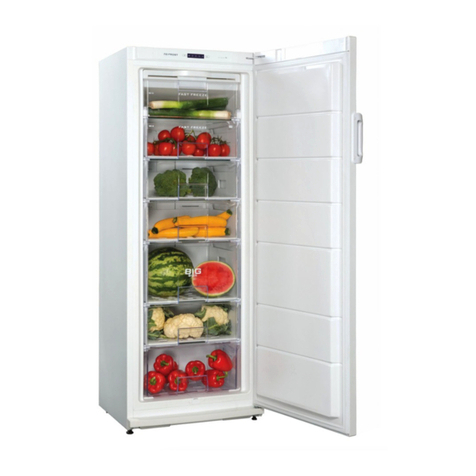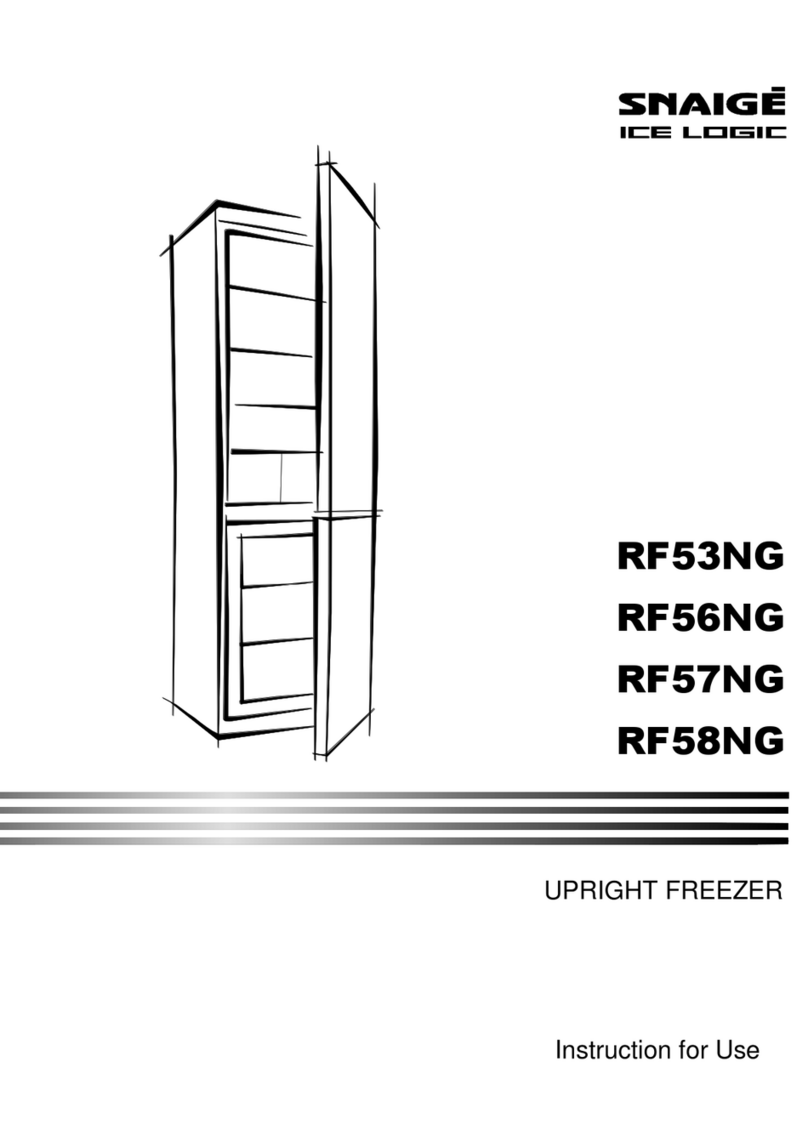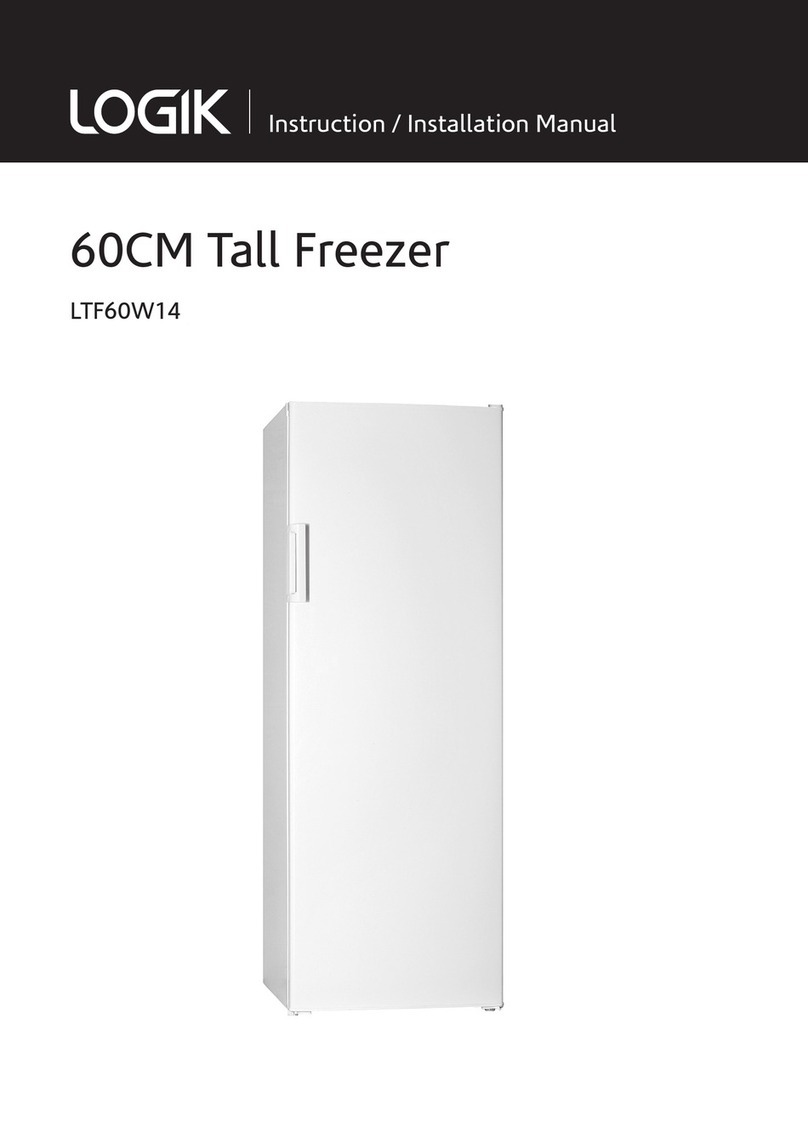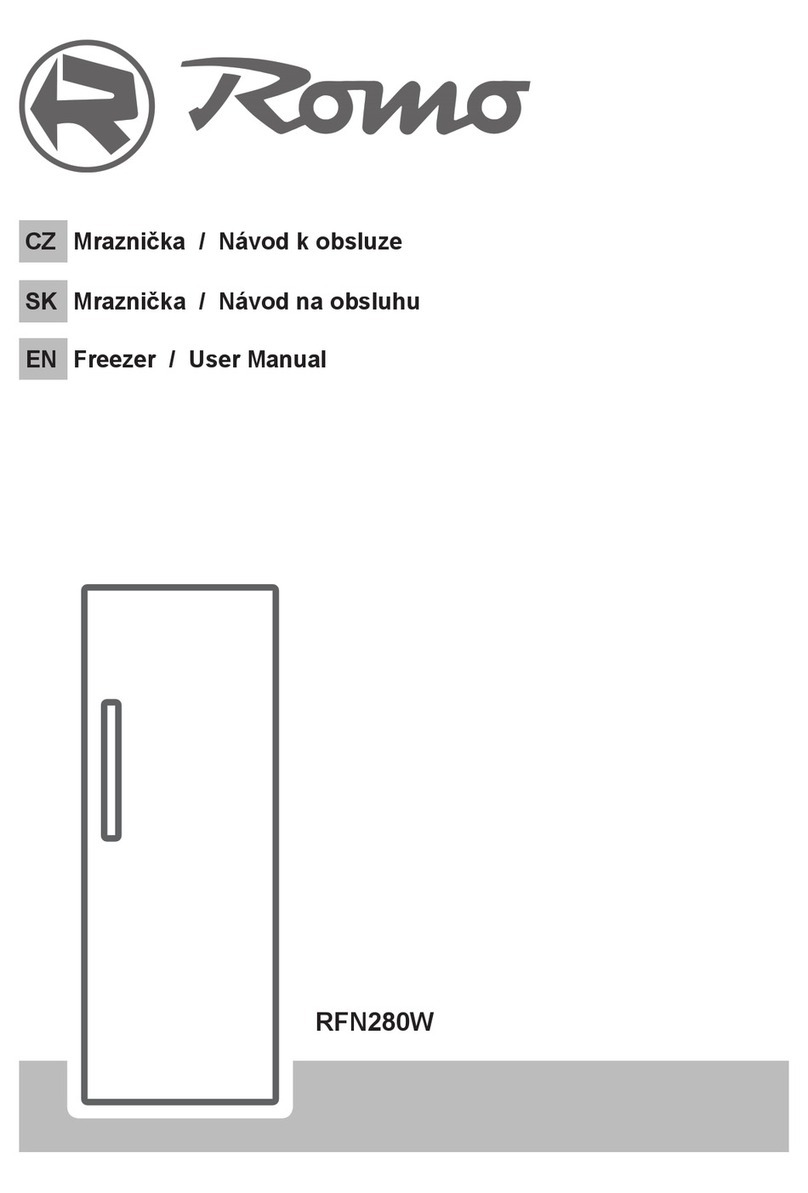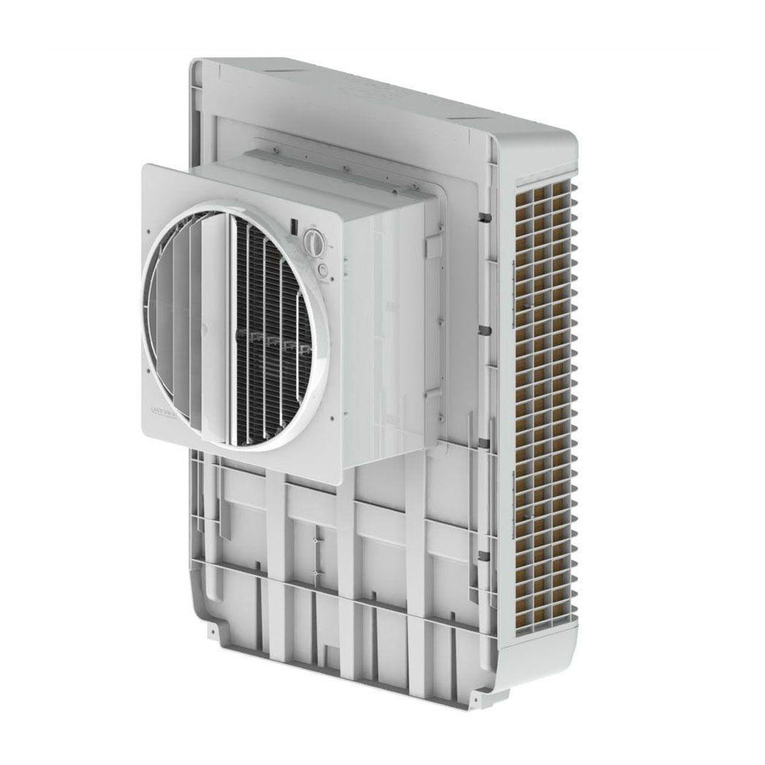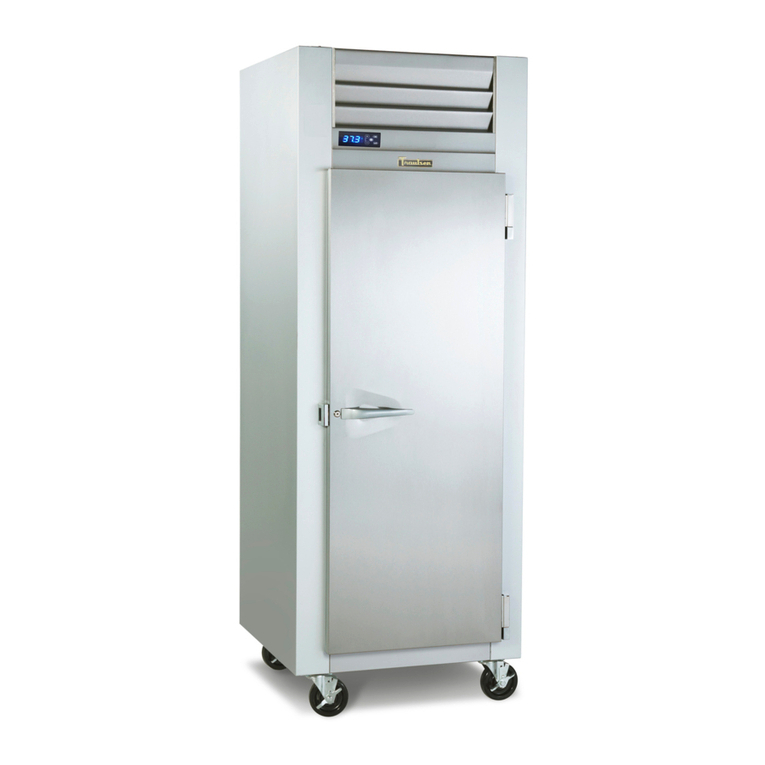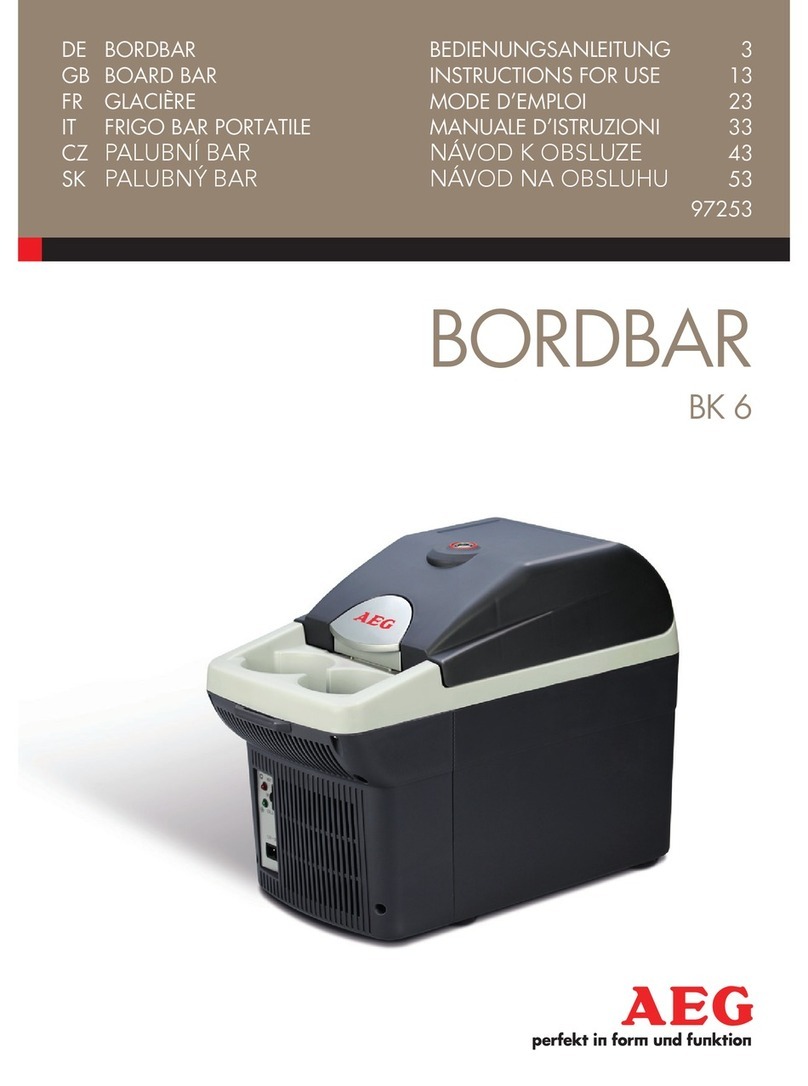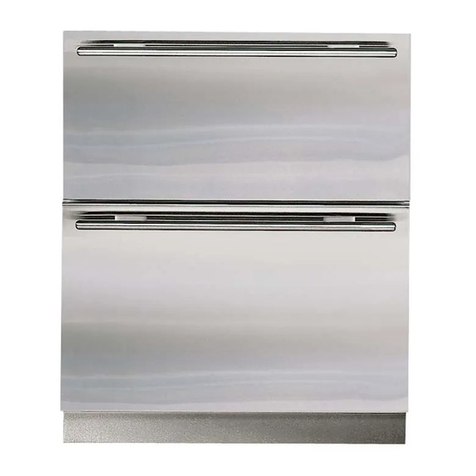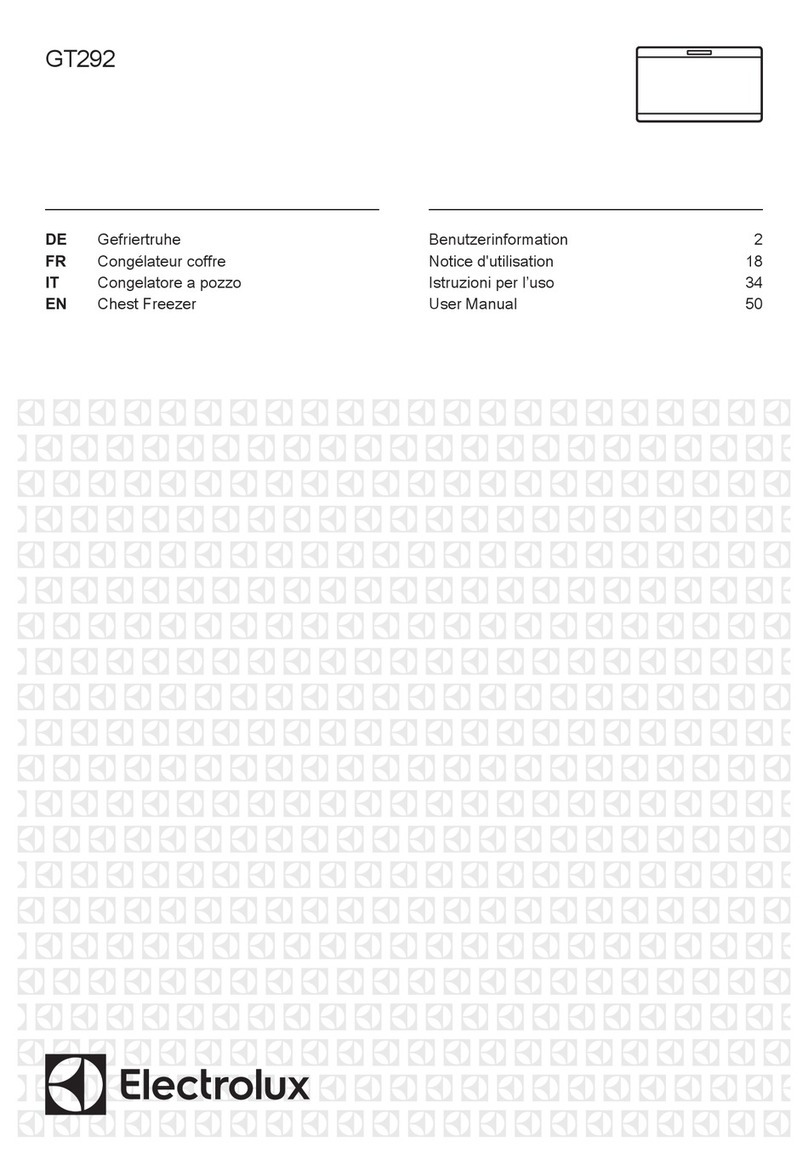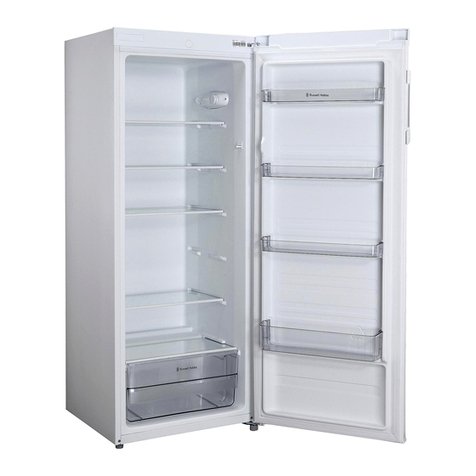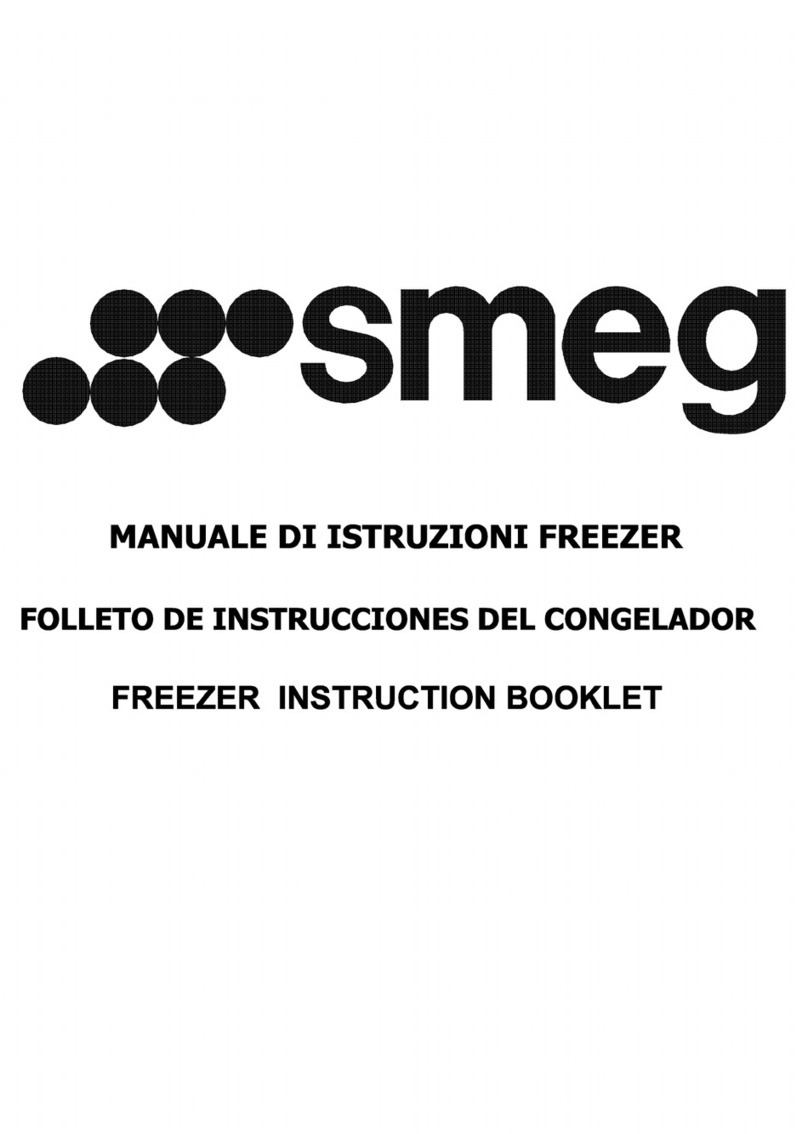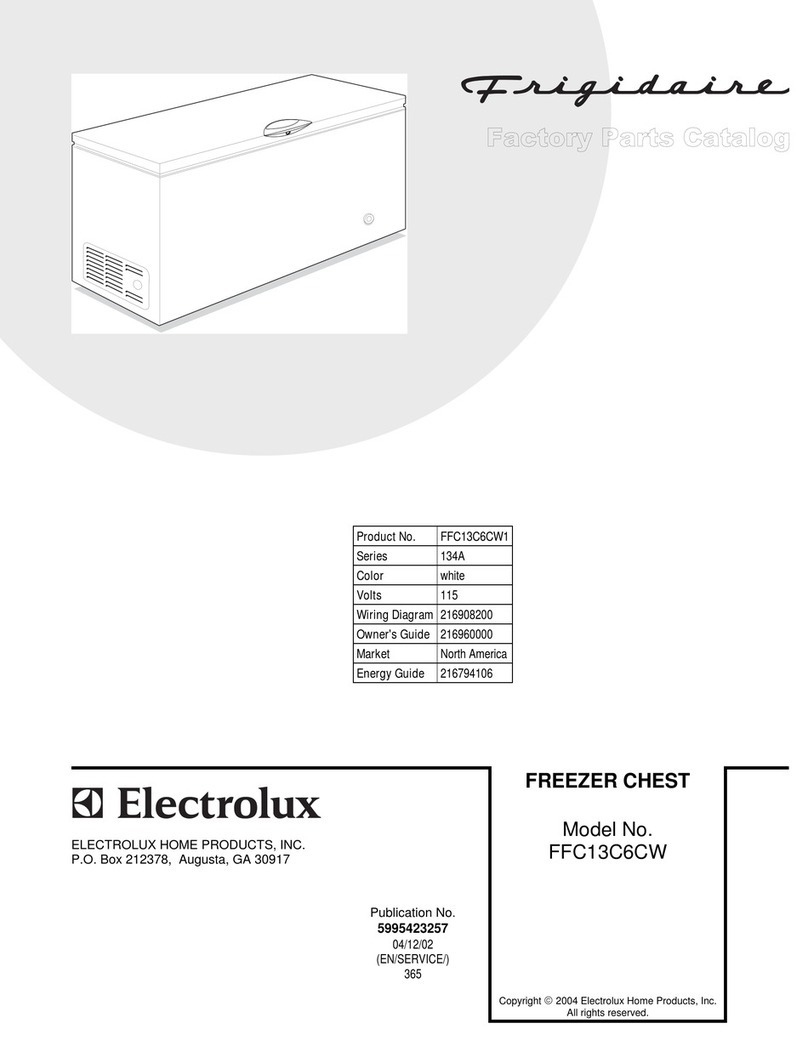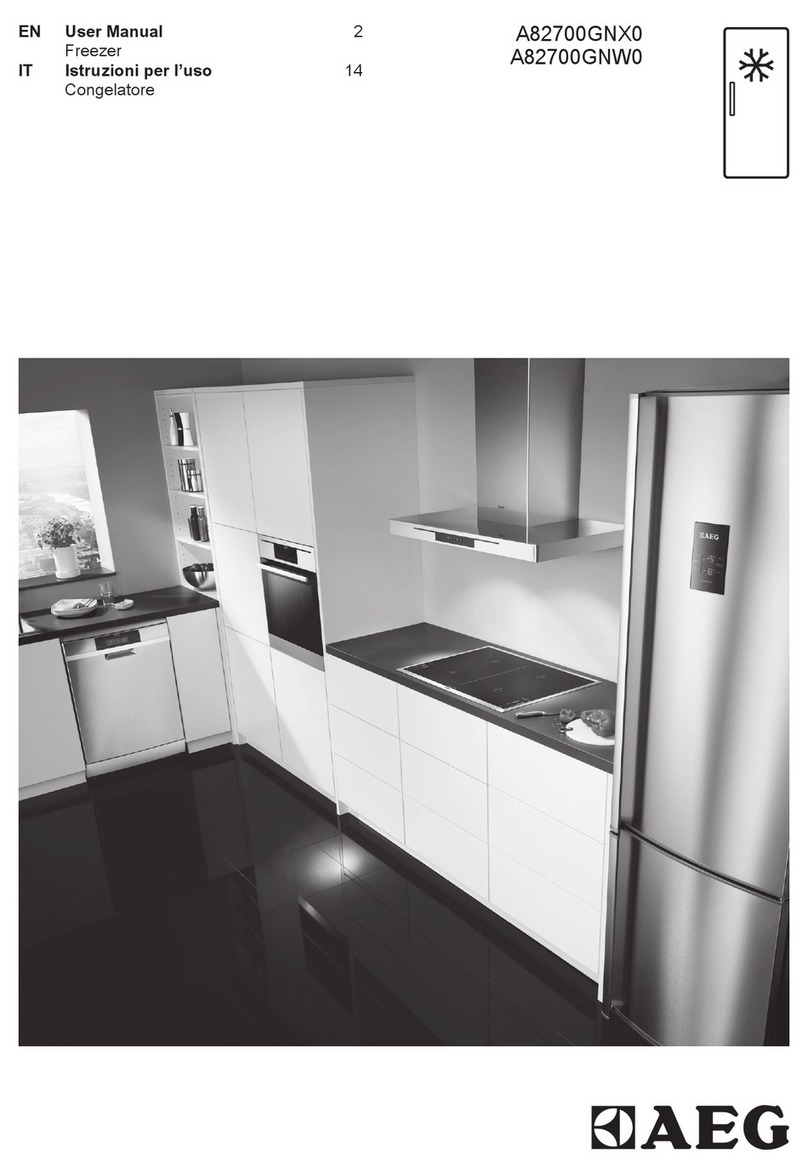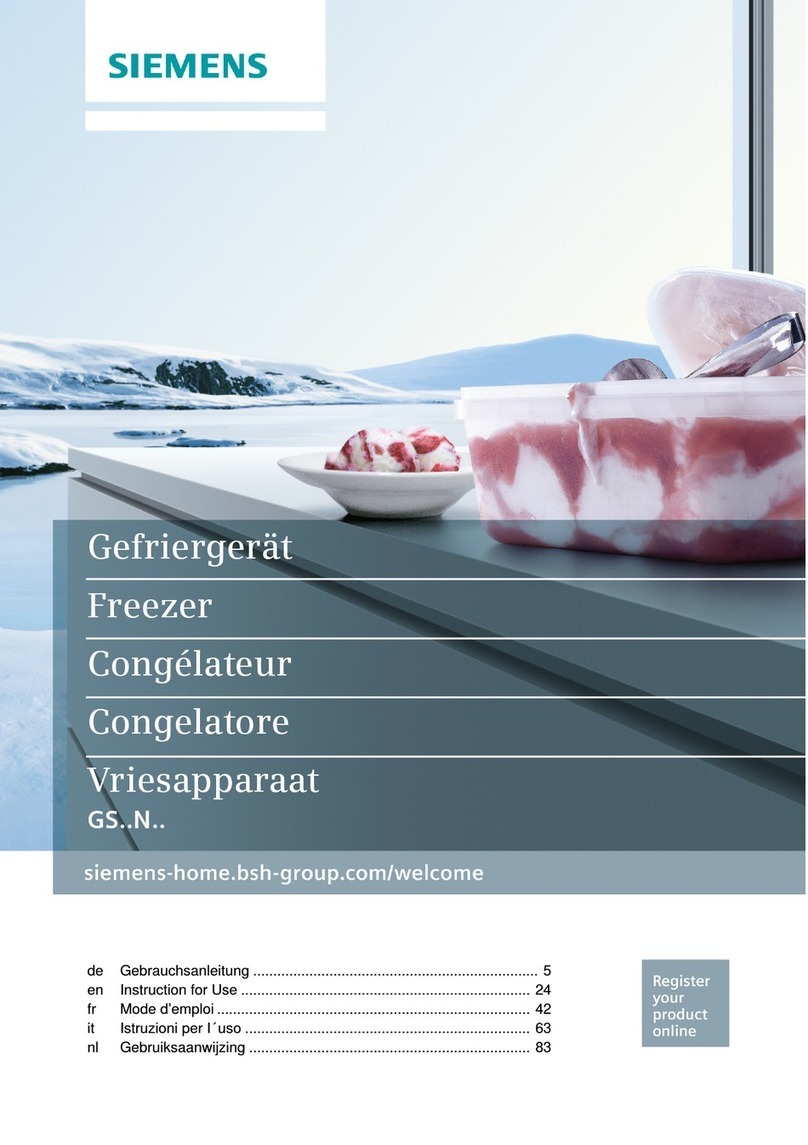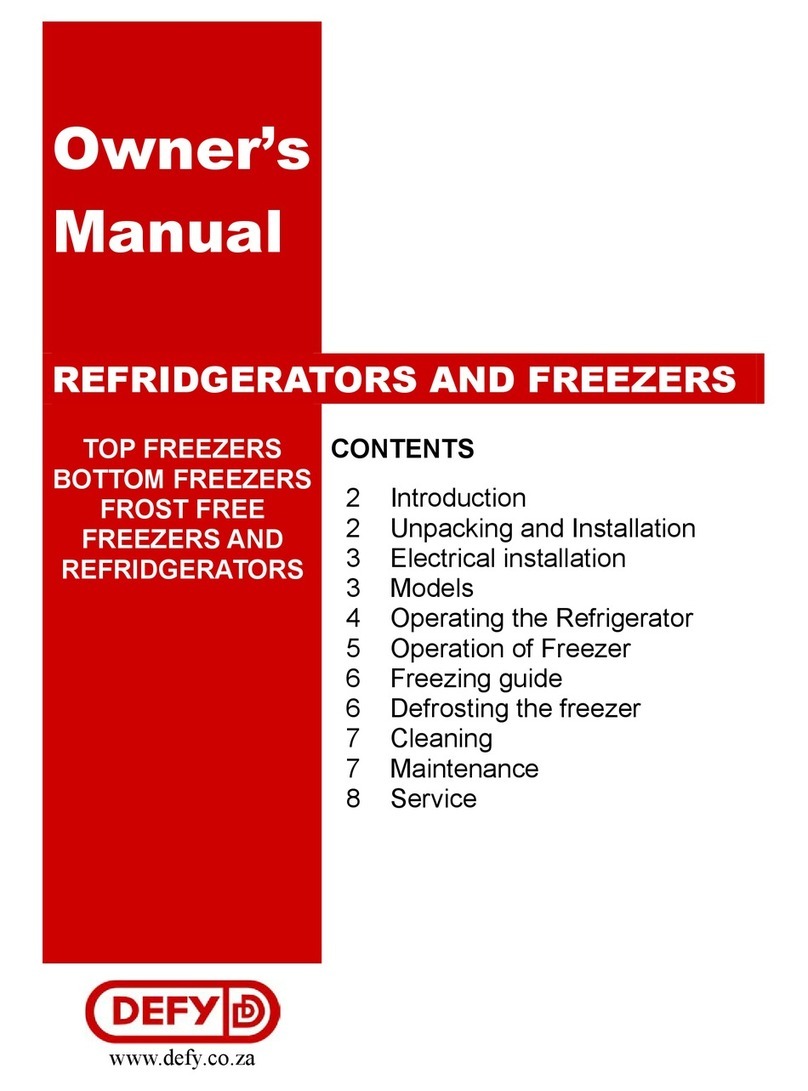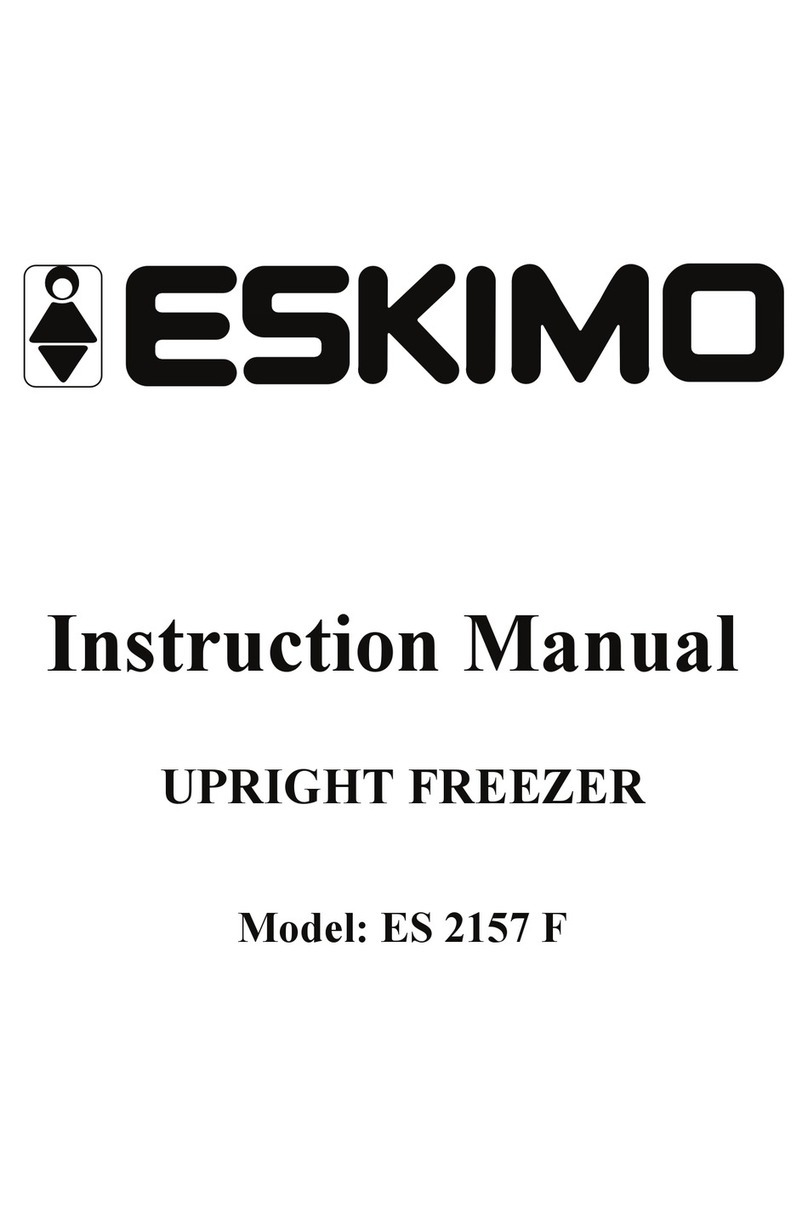SNAIGE F 22SM User manual

UPRIGHT FREEZER
Instruction for Use
F 22SM
F 27SM
F 10SM

1
DEAR CUSTOMER!
Some provisions in this user manual are unified for refrigerating products of different types
(for a refrigerator, refrigerator-freezer or freezer). CAREFULLY READ THE INSTRUCTION
MANUAL.
The Manufacturer shall not be held liable for damage arising from the failure to observe
the instructions contained in this manual.
Keep this manual for future reference, or to pass it over to the next user.
General information:
Refrigeration appliance - a household freezer intended for household use. The freezer
compartment is designed for freezing and storing food for a long time.
The device can be used, for example, in the dining rooms of staff in shops, offices and
other establishments, in the kitchens of student dormitories, in hotels, in country houses,
in guesthouses and in the kitchens of other living quarters.
CE conformity. At the time of its market launch, this appliance complies with the
requirements stipulated in the guidelines of the council for the harmonization of the legal
provisions of the member states on electromagnetic compatibility Directive 2014/30 / EU
and on the use of electrical equipment within certain voltage limits Directive 2014/35 / EU.
This appliance is marked with the CE mark and has a declaration of conformity for
inspection by the responsible market surveillance authorities.
GUIDELINES CONCERNING THE SAFETY OF USE
General safety requirements:
–WARNING: Keep ventilation openings, in the appliance enclosure or in the built-in
structure, clear of obstruction.
–WARNING: Do not use mechanical devices or other means to accelerate the
defrosting process, other than those recommended by the manufacturer.
–WARNING: Do not use electrical appliances inside the food storage
compartments of the appliance, unless they are of the type recommended by the
manufacturer.
–WARNING: When positioning the appliance, ensure the supply cord is not
trapped or damaged.
–WARNING: Do not locate multiple portable socket-outlets or portable power
supplies at the rear of the appliance.
WARNING: Do not damage the appliance refrigeration system. It contains
the refrigerant gas R600a. If the refrigeration system is damaged:
•Do not use any open flame.
•Avoid sparks-do not turn on any electrical appliances or lighting fixtures.

2
•Immediately ventilate the room: air the room in which the appliance is placed for a
few minutes (the size of the room for a product containing isobuthane / R600a
must be at least 4 m3) to avoid damage to the cooling system.
C-Pentane is used as blowing agent in the insulation foam and it is a
flammable gas.
–WARNING: Disposal of the appliance should be according to national rules.
–This appliance is not designed for the storage of explosive substances such as
aerosol cans with a flammable propellant.
–It is prohibited to store petrol and other flammable liquids near the appliance.
–The appliance should be used only for storing foodstuffs.
Children and vulnerable people safety:
–Do not allow children to play with the appliance or to plug it in or unplug from the
electricity supply socket. Do not allow children to play with the packaging material
from the appliance.
–This appliance can be used by children aged from 8 years and above and persons
with reduced physical, sensory or mental capabilities or lack of experience and
knowledge if they have been given supervision or instruction concerning use of the
appliance in a safe way and understand the hazards involved.
–Cleaning and user maintenance shall not be made by children without
supervision.
–Children aged from 3 to 8 years are allowed to load and unload refrigerating
appliances.
Requirements for the connection to the mains:
–The appliance should only be connected to an earthed socket installed in
accordance with the regulations. Make sure that the supply voltage corresponds
with the voltage marked on the rating label. This product complies with all binding
CE labelling directives. The earthed electrical socket by which the appliance is
connected to the mains should be in an accessible place. It is a legal requirement
that the appliance is properly earthed. The manufacturer will not be held liable for
any damage or injury which may result from the failure to fulfil this requirement.
–To avoid the exposure to danger, always have faulty cable be replaced only by
the manufacturer, by our customer service or by qualified person and with a cable
of the same type.
–It is forbidden to readjust or modify any parts of the unit. It is crucial not to
damage the capillary tube visible in the compressor recess. The tube may not be

3
bent, straightened or wound. If the capillary tube is damaged by the user the
guarantee will be void.
–Do not use adapters, multiple sockets and two-wire extension leads. If it is
necessary to use the extension lead, it must be equipped with a protection ring
and a single socket and must have a VDE/GS safety certificate. If an extension
lead is used (with a protection ring and safety certificate), its socket must be
located at a safe distance, away from the sinks, and must not be in a place where
it could be flooded by water or waste water.
–The frequency and power of the electricity supply in your house must conform to
the general data parameters of the appliance as it is shown in the product label.
–When positioning the appliance, be careful that the electrical cord isn’t squeezed
in order to avoid its damage. Do not store heavy objects such as cooling devices
or other devices next the appliance in such a way that they could squeeze and
damage the electrical cord. This can cause a short circuit and a fire.
–Make sure that the plug of the electrical cord is not squeezed by the back wall of
the appliance or otherwise damaged. A damaged plug can be the cause of a fire!
Do not try repair the appliance on your own. Always contact an authorized
technician. To avoid the exposure to danger, always have faulty cable be
replaced only by the manufacturer, by our customer service or by qualified
person whit a cable of same type.
Requirements for safe use:
–It is forbidden to use a technically damaged appliance.
–If the appliance is unplugged (for cleaning, moving to another place, etc.), it may
be repeatedly switched on after 15 min.
–When performing activities, such as cleaning, maintenance or moving, the
appliance must be completely disconnected from power supply (by pulling the plug
out from the socket). Do not pull on the cord, but hold the body of the plug
instead.
–Do not set up the device outdoors.
–In an emergency, pull the power plug out of the socket immediately.
–Do not place any switched on electrical devices on top of the appliance because
this may cause ignition of plastic parts. Do not place any dishes with liquids on
top of the appliance and do not keep flowers in vases or other liquid-filled vessels
on the appliance.
–Do not climb on or sit on the appliance, do not lean on or hang on the appliance
doors and do not allow children to do this.
–Do not remove or touch items from the freezer compartment if your hands are wet
or damp.

4
–Do not use water spray and steam to clean the appliance.
The appliance should be transported in the vertical position; do not
tilt any more than 30°. The manufacturer will not be responsible for any
damage of the appliance that results from non-compliance with the
instructions for transportation.
The manufacturer guarantees reliable operation of the refrigerator when
the relative air humidity not greater than 70 per cent and the ambient
temperature is:
+16 TO +32 DEGREES CELSIUS (Climate class N);
+16 TO +38 DEGREES CELSIUS (Climate class ST);
+16 TO +43 DEGREES CELSIUS (Climate class T).
INSTALLATION AND OPERATING CONDITIONS
Positioning:
•This appliance can be installed in a dry, well ventilated indoor where the ambient
temperature corresponds to the climate class indicated on the rating plate of the
appliance.
Do not install this appliance in areas that are too humid or too colds, such as the
construction appendices, garages or wine cellars. Place the appliance away
from heat sources such as kitchen stove/oven, radiators, or
direct sunlight. The appliance must not touch any pipes for
heating, gas or water supply, or any other electrical
devices.
Minimum distances from the heat sources:
- from the electric gas and other ovens - 30 mm,
- from oil or coal fired ovens - 300 mm,
- from built-in ovens - 50 mm
If there is no possibility of ensuring the above-
mentioned distances, provide an appropriate
insulation board
•Do not cover the ventilation holes at the top of
the appliances –it must be a good air
circulation around the appliance. There
should be a gap of at least 10 cm between the top of the
appliance body and any furniture that may be above it. If this
requirement is not followed, the appliance consumes more
electrical energy and its compressor may overheat (see
fig.).
•The appliance must stand on a level surface
and must not touch the wall. If necessary,
regulate the height of the appliance by adjusting
F 10SM F 22SM, F 27SM

5
the levelling feet: by turning them clockwise –the front of the appliance rises, by turning
them counter clockwise –it comes down. If the appliance is tilted slightly backward –
the doors will close by themselves.
•If the appliance is placed in a corner, a gap must be left between the appliance body
and the wall so that the freezer compartment door can be opened enough to pull out the
frozen product drawer (see fig.).
Preparing for operation:
It is recommended to prepare the appliance for operation with a helper.
•The apppliance must only be transported in its vertical position; do not tilt any more than
30°.
•Remove package. Lift the appliance away from foamed polystyrene base. Tear off
adhesive tapes. Remove all red-coloured parts from the shelves. NOTE. When you open
the freezer compartment door a little red packing detail will fall out –it is for
transportation purposes only.
•When positioning the appliance F 22SM and F
27SM in chosen location, it will move more easily
into position if you lift the front a little and incline
it backward, allowing it to roll on its casters.
When placing, moving, lifting the appliance,
do not hold the door handles, do not pull the
condenser at the rear part of the refrigerator and do not touch the compressor
unit.
•When placing F 22SM and F 27SM take two supports 1from the bag and insert them
into the guides 2at the top back part of the appliance.
•The appliance should not be connected to the mains until all packing and
transport materials aren’t removed. Suitably dispose the packaging material.
First use:
Before using the appliance for the first time, the interior and all internal accessories should
be washed with lukewarm water and some neutral soap to remove the typical smell of a
brandnew product, then dried thoroughly.
F 10SM F 22SM, F 27SM

6
If the unit has been tilted more than 30° during transport: wait at
least 4 hours before connecting the appliance to the power
supply. If this is not done, the appliance compressor may fail.
•When first starting-up or after a period out of use, before putting the products in the
compartment let the appliance run at least 2 hours.
DESCRIPTION OF THE APPLIANCE, BASIC PARTS
The appliance accessories listed below may differ from the accessories of the
appliance you have bought in quantity and in design. This description is adapted for
entire group of freezer.
F 22SM F 27SM
F 10SM

7
1―THERMOSTAT KNOB. The temperature in the appliance is controlled using the
thermostat knob by turning it to one side or the other. More in “Temperature
regulation”.
2 ― ELECTRICITY SUPPLY INDICATOR. When the appliance is connected to the
electricity supply, the green indicator light is illuminated. Simultaneously also the the
temperature rise indicator lights up. It indicates that the freezer was switched off
for a longer time, i.e. the freezer is switched on for the first time, after defrosting or
after losing of voltage. When the temperature in the compartment again falls below
-9 ºC, the temperature rise indicator light will go out.
3― THE TEMPERATURE RISE INDICATOR. When the temperature in the freezer rises
above -9 ºC, the red indicator light is illuminated. It indicates that:
•The freezer was switched off for a longer time, i.e. the freezer is switched on for the
first time, after defrosting or after losing of voltage.
•The door of the freezer is opened or is being opened too frequently.
•It is loaded a large amount of unfrozen foodstuffs.
•The freezing system is failed, i.e. the indicator does not go out longer 6
hours and it is heard running compressor or the compressor does not
switch off. In this case you should apply to your service agent (at first
make sure that three above items were taken into account).
NOTE. The technical data of the appliance can be found on the rating label attached to
the inside wall of the appliance. For more information about the appliance, scan the QR
code on the enclosed energy label and / or visit the official website of the product
database: https://eprel.ec.europa.eu
TEMPERATURE REGULATION
Temperature set in the freezer by the manufacturer is -18 0C. Please set the desired
temperature in the appliance according to your own requirements.
The temperature in the appliance is controlled using the thermostat knob 1by turning it to
one side or the other. The temperature indication in digits is shown beside the thermostat
knob. The number “0, 2, 3, 4, 5, 6, 7”do not mean a specific temperatures.
In the freezers F 22SM and F 27SM the temperature is regulated on the scale of seven
digits:
0= Compressor is switched off. W A R N ING! Electric current is not switched off.
1= highest temperature (lowest cooling)
7= lowest temperature (highest cooling)
In the freezer F 10SM the temperature is regulated on a four-digit scale:
• = Compressor is switched off. ATTENTION! The voltage is not switched off.
1
Thermostat knob
4
Fast-freeze section
2
Power supply indication
5
Frozen products section(s)
3
Temperature rise indicator
(Red color)
6
Condenser
7
Compressor

8
4 = lowest temperature (maximum refrigeration)
The numbers do not mean a specific temperatures.
The temperature in the freezer compartment can vary due to the ambient
temperature, the amount of food, and the frequent opening of the freezer door.
IF THE ROOM IS COOL, THE APPLIANCE COOLS LESS. THE TEMPERATURE IN THE
APPLIANCE MAY THEREFORE RISE. Use the thermostat wheel to set a lower
temperature.
FREEZING AND STORAGE OF FOODSTUFFS
To avoid food contamination, follow the instructions below:
•Prolonged opening of the door can significantly increase the temperature in the
compartments of the appliance.
•Regularly clean surfaces that may come into contact with food and accessible drainage
systems.
•Store fresh meat and fish in suitable containers in the refrigerator so that they do not
come into contact with or drip on other food.
•If the refrigerator is left empty for a long time, switch it off, defrost, clean, dry and leave
the door open to prevent mold inside the appliance.
When you intend to freeze fresh food, place it in the fast freeze section 4 (see fig. 1).
Transfer frozen food from the quick-freeze compartment to the drawer (s) in the storage
compartment.
DO NOT EXCEED THE MAXIMUM AMOUNT OF FROZEN FOOD INDICATED IN THE
PRODUCTS DATA SHEET.
•Leave not less than 2.5 cm gap between a top of frozen
products and a bottom of drawer, which is over them.
•Do not place unwrapped foodstuffs in the freezer sections.
•Do not refreeze partly thawed products. Fresh food
for freezing should not touch already frozen foodstuffs.
•Do not freeze foodstuffs that are warmer than the room
temperature.
•WARNING! Do not freeze liquid foodstuffs in glass vessels or bottles.
•Strictly observe the frozen foodstuffs validity dates indicated by the manufacturer on the
product packaging.
•WE RECOMMEND THAT FROZEN FISH AND SAUSAGE SHOULD BE STORED IN THE
FREEZER COMPARTMENT NOT LONGER THAN 6 MONTHS; CHEESE, POULTRY, PORK,
LAMB –NOT MORE THAN 8 MONTHS; BEEF, FRUIT AND VEGETABLES –NOT LONGER
THAN 12 MONTHS.
CAUTION! In the event of accidental defrosting, for example due to a power failure, if the
power has been off for longer than the value shown in the technical characteristics chart
under "rising time", the defrosted food must be consumed quickly or cooked immediately
and then refrozen (after cooling).

9
DEFROSTING, CLEANING AND CARE
The freezer compartment should be thawed not less than twice a year or when a layer of
ice thicker than 5 mm forms in it. Do the actions below in the order they are listed:
WARNING ! Turn the appliance off and pull the plug out of the electrical
socket.
•Remove food from the freezer compartment. The frozen
foodstuffs will not warm up too much while you are thawing the
freezer compartment if you cover them with a thick cloth and
keep them in a cool place.
•F 22SM, F 27SM (see fig. 4): Pull out the melt water gutter, turn
it 180° and hook it up. After thawing, place the container with
the water gutter.
•Leave the freezer door open. After the frost has thawed, dry the
inside of the freezer and the accessories dry.
•F 22SM, F 27SM: Remove the melt water gutter, turn it 180o
again and replace it.
•Close the freezer door and turn on.
CLEAN THE FREEZER REGULARLY.
Note: before cleaning the cooling device and its rear compartment part,
the device must be disconnected from the mains by unplugging.
•Protect the appliance inner surfaces and plastic parts from fats, acids and sauces. In
case of accidental spills –immediately clean with warm soapy water or dishwashing
detergent. Wipe dry.
•Regularly clean the hermetic gaskets of the doors. Wipe dry.
•At least once a year clean dust away from the back part of the appliance body and the
compressor. A soft brush, electrostatic cloth or vacuum cleaner may be used for
cleaning.
•DO NOT use detergents containing abrasive particles, acid, alcohol or benzene for
cleaning the appliance inner and outer surfaces. DO NOT use for cleaning cloths or
sponges that have coarse surfaces intended for scrubbing
F 10SM

10
CHANGING THE OPENING DIRECTION OF THE DOORS
It is recommended that changing the opening direction of the doors should be done with a
helper. You will need two spanners No. 8 and No. 10 and a head screwdriver.
When changing the opening direction of the doors, YOU CAN NOT lay the
freezer horizontally!
•Do the actions below in the order they are listed:
F 22SM, F 27SM:
WARNING ! Turn off the freezer and pull the plug out of the electricity supply outlet.
1. Remove covers c from the inside of the housing and door and the upper bracket 6
together with the nut and washers and the gasket under the bracket.
2. Remove the freezer door 1. Remove the stop plate from the bottom 2. Screw the stop
plate (included in the package) on the opposite side of the door to open the door to the
left.
3. Remove the bottom cover 3together with the small cover 4.
4. Unscrew the shaft 5together with the washers on the shaft and the catch 8from the
lower bracket 6and screw them to the bracket 7on the other side of the cabinet
symmetrically to the former position.
5. Push the freezer door onto the bracket 7on the newly installed shaft 5.

11
6. Remove the screw caps a and the blinds b. Unscrew the 9fixing screws of the handle
and screw the handle on the opposite side of the door. Press the blinds into the remaining
holes in the door and place the covers on the screws.
7. Rotate the bracket 6together with the washers on the shaft and the plastic gasket at
an angle of 180 °. Unscrew the shaft together with the washers and screw in on the
opposite side of the bracket. After inserting the axis 6of the bracket into the door of the
refrigerator compartment, screw it on the opposite side of the refrigerator in the lower
holes. Cover cwith the bracket and the remaining empty cavity.
8. Insert the cover 4into the guides on the opposite side of the bottom cover 3. Replace
the bottom cover 3 in its original position.
Wait for about 30 minutes before it is connected to the mains. If the unit has been tilted
to more than 30°, wait for about 4 hours before re-connecting it to the mains.
F 10SM:
WARNING! Turn off the freezer and pull the plug out of the electricity supply outlet.
1. Remove support 1and undo screws 2.
2. Undo the two screws 3that hold the pull-out shelf.
3. Remove pull-out shelf 4.
4. Take off bracket 5together with the washers that are on the axle.
5. Unscrew the axle from bracket 5together with its washers and screw it into the second
aperture of bracket 5.
6. Remove compartment door.
7. Remove plug 7from freezer door and press it in on the opposite side.
8. Take off bottom bracket 8together with the washers that are on the axle. Unscrew the
axle by turning it counter-clockwise. Turn bracket 6around a full 180° and screw the
axle back in. Fix the bracket in place on the opposite side.
9. Mount freezer door on the axle of bracket 8.
10. Fix bracket 5 in place together with the washers that are on the axle.
11. Put the pull-out shelf back in place and replace screws 2and 3. Place support 1in the
groove at the top back part of the freezer.
12. Remove bolt caps aand plugs b. Unscrew the bolts holding the handles in place. Move
the handles to the other side. Screw on. Press plugs into the remaining apertures in
the door and cover bolts with caps a.
Wait for about 30 minutes before it is connected to the mains. If the unit has been tilted
to more than 30°, wait for about 4 hours before re-connecting it to the mains.

12
OPERATION PROBLEMS AND THEIR SOLUTIONS
•The appliance is plugged in to the mains but it does not work and the
electricity supply voltage indicator is not illuminated. Check that your house
electricity supply installations are in order. Check that the plug is correctly inserted into
the electricity supply socket.
•The noise has become louder. Check that the appliance is standing stable on a level
place. To make it level, regulate the front feet. Check if the appliance is not touching any
furniture and that no part of the refrigeration system at the back part of the appliance
body is touching the wall. Pull the appliance away from any furniture or walls. Check
that the cause of increased noise isn’t due to bottles, cans or dishes in the appliance that
might be touching each other.
•When the appliance door is opened, the rubber sealing gasket pulls out. The
gasket is smeared with sticky foodstuffs (fat, syrup). Clean the sealing gasket and the
groove for it with warm water containing soap or dishwashing detergent and wipe dry.
Put the rubber sealing gasket back into the place.
•The temperature rise indicator light is illuminated red. This means the appliance
is being connected to the electricity supply for the first time or it was disconnected for a
significant period (for thawing or during an interruption to the electricity supply), the
freezer door is not closed or is being frequently opened and closed, or a large amount of
fresh food has been put in, and therefore the temperature in the compartment has risen
above -9 ºC. When the temperature in the compartment again falls below -9 ºC, the
indicator light will go out.
ATTENTION! If the temperature indicator light does not go out (for reasons other than
those listed above) for longer than six hours, the compressor is either working constantly
or is not functioning. You need to consult service people.
•High temperature in appliance, the compressor operation pauses are short.
Ascertain whether the appliance door are shutting tightly, whether the door wasn’t kept
open longer than necessary when taking out or putting in foodstuffs or whether a large
amount of warm food was placed in the appliance.
•The top of the appliance has condensation on it. The ambient relative air
humidity is above 70 %. Ventilate the room where the appliance stands and if
possible remove the cause of the humidity.
R em a r ks o n t h e a p pl i a nc e o p e ra t i ng n oi s e . As the appliance
operates and goes through the freezing cycle, various noises will be emitted. This is
normal and is not a sign of any malfunction.
•As the refrigerant circulates around the refrigeration system, it causes sounds like
murmuring, bubbling, or rustling. Louder sounds like popping or clicking may be heard
for a short time as the refrigerator’s compressor switches on.

13
ENVIRONMENTAL PROTECTION INFORMATION
Important Note:
This appliance is marked according to the European directive 2002/96/EC on Waste
Electrical and Electronic Equipment (WEEE). By ensuring this product is disposed of
correctly, you will help prevent potential negative consequences for the environment and
human health, which could otherwise be caused by inappropriate waste handling of this
product.
The symbol on the product, or on the documents accompanying the product,
indicates that this appliance may not be treated as household waste. Instead it
shall be handed over to the applicable collection point for the recycling of
electrical
and electronic equipment.
Disposal must be carried out in accordance with local environmental regulations for waste
disposal. For more detailed information about treatment, recovery and recycling of this
product, please contact your local authority, your household waste disposal service or the
retailer where you purchased the product.
Our packaging are made of environmentally friendly materials, which can be reused:
● The external packaging is made of cardboard/foil
● The FCKW free shape of foamed polystyrene (PS)
● Polyethylene (PE) foils and bags
The refrigerants and foaming agents, which are 100% free of FCKW and FKW have been
used for manufacturing our product. Therefore we are helping to protect the ozone layer
and prevent the increase of greenhouse effects. Also, the innovative technology and
environmentally friendly insulation help in reducing energy consumption.
RISK FROM OLD APPLIANCE!
Keep children under the age of 8 away from the power cord of the appliance. Keep
children away from the packaging materials.
Playing children can lock themselves in the device or get into other life-threatening
situations.
• Remove or destroy existing snap locks and bolt locks.
• Do not let children play with the appliance.
• Always supervise children in the vicinity of the old appliance.
This manual suits for next models
2
Table of contents
Other SNAIGE Freezer manuals

